Abstract
A group of individuals behaves as a population system when patterns of connections among individuals influence population health outcomes. Epidemiology usually treats populations as collections of independent individuals rather than as systems of interacting individuals. An appropriate theoretical structure, which includes the determinants of connections among individuals, is needed to develop a "population system epidemiology." Infection transmission models and sufficient-component cause models provide contrasting templates for the needed theoretical structure. Sufficient-component cause models focus on joint effects of multiple exposures in individuals. They handle time and interactions between individuals in the definition of variables and assume that populations are the sum of their individuals. Transmission models, in contrast, model interactions among individuals over time. Their nonlinear structure means that population risks are not simply the sum of individual risks. The theoretical base for "population system epidemiology" should integrate both approaches. It should model joint effects of multiple exposures in individuals as time related processes while incorporating the determinants and effects of interactions among individuals. Recent advances in G-estimation and discrete individual transmission model formulation provide opportunities for such integration.
Full text
PDF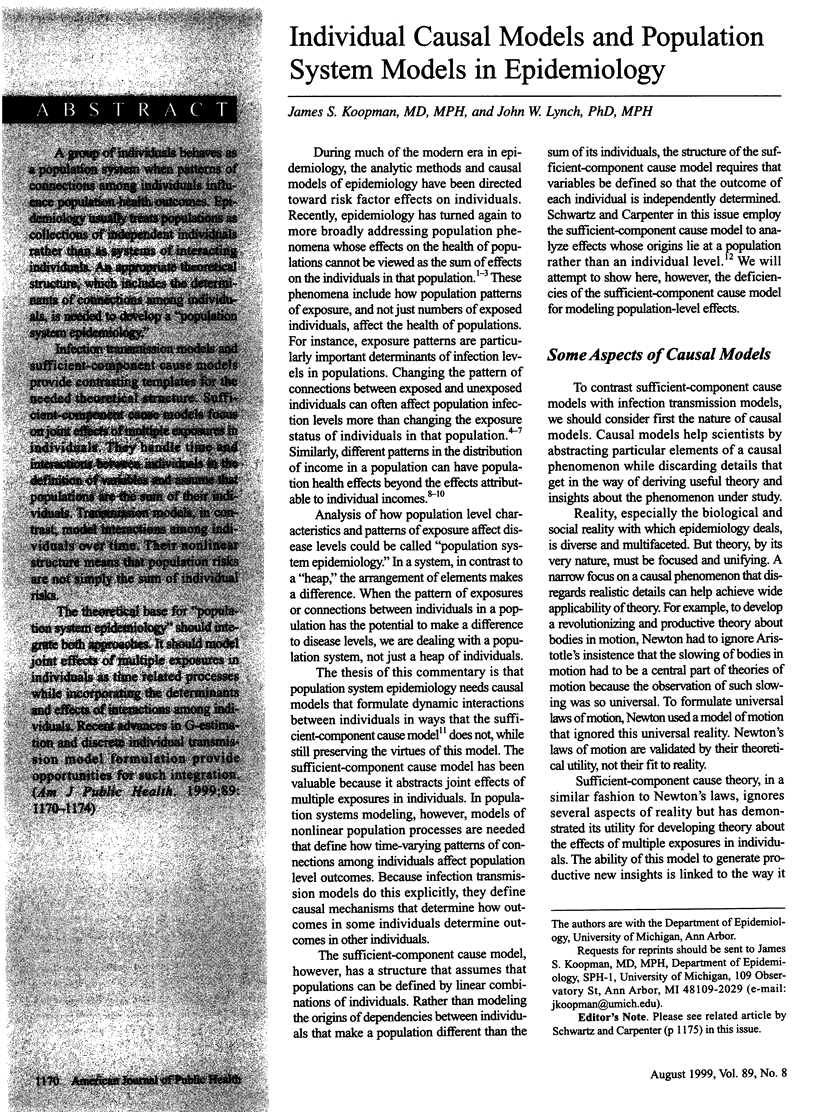
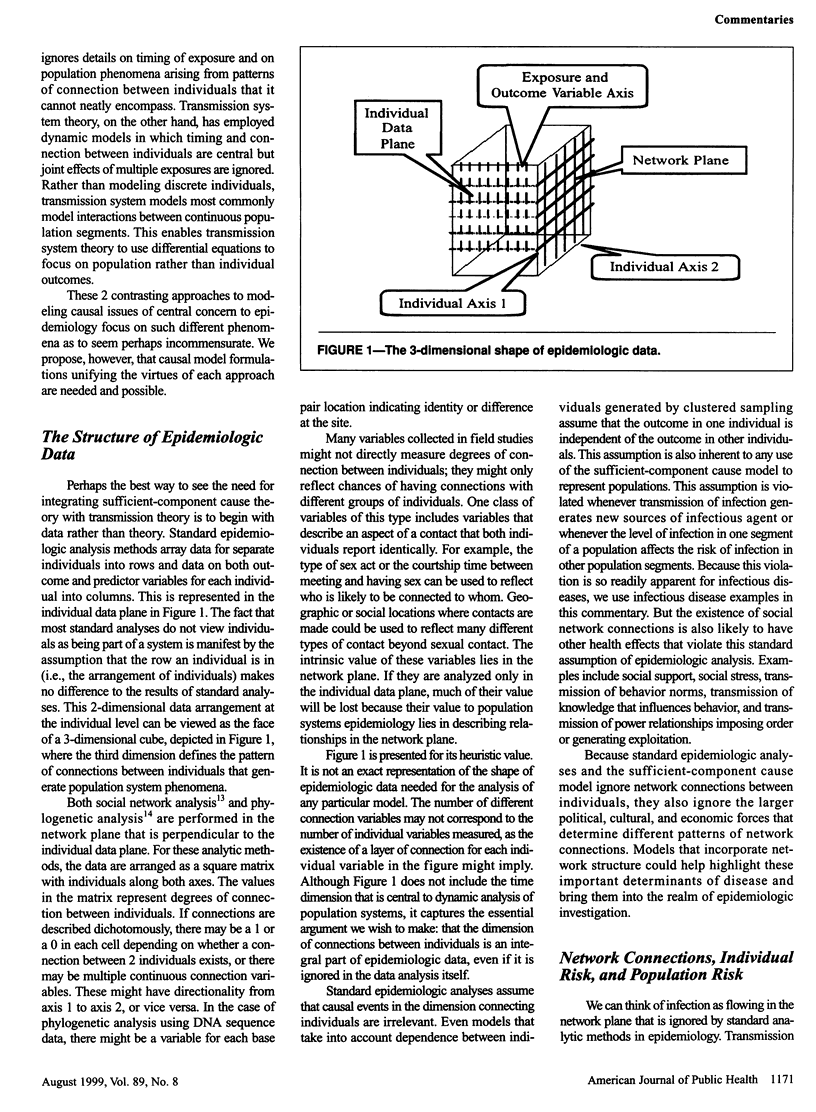
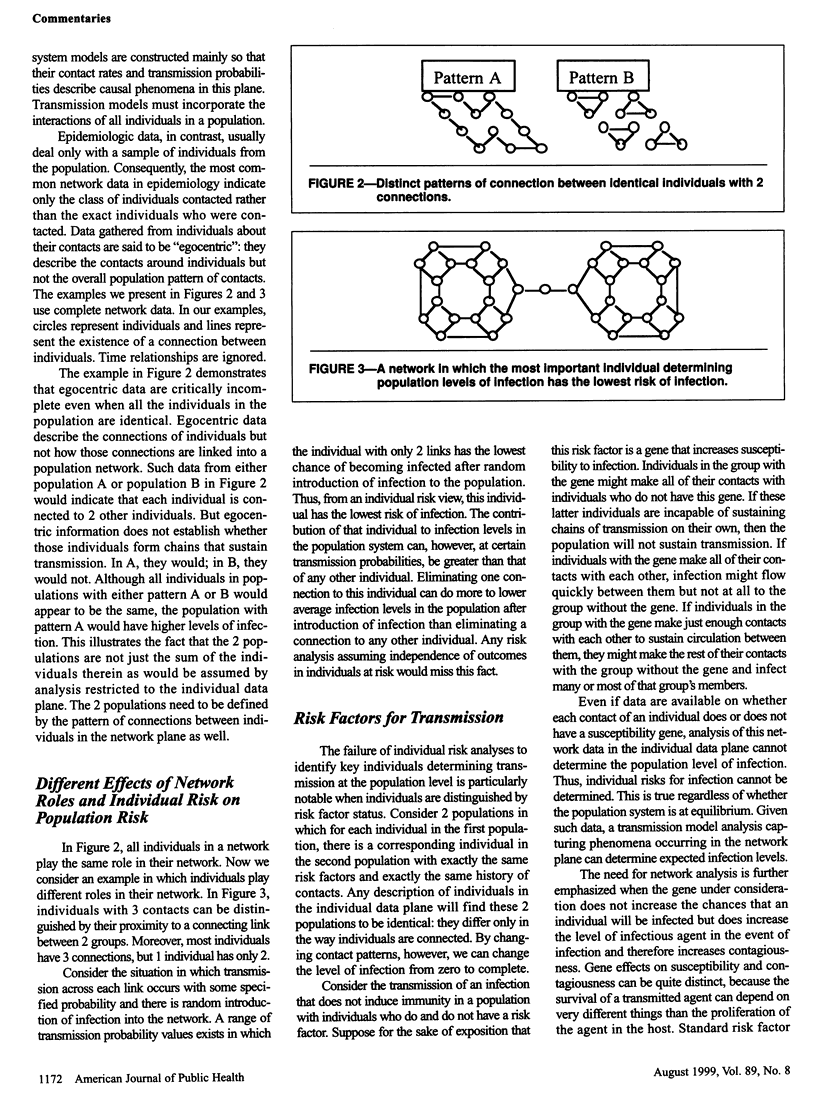
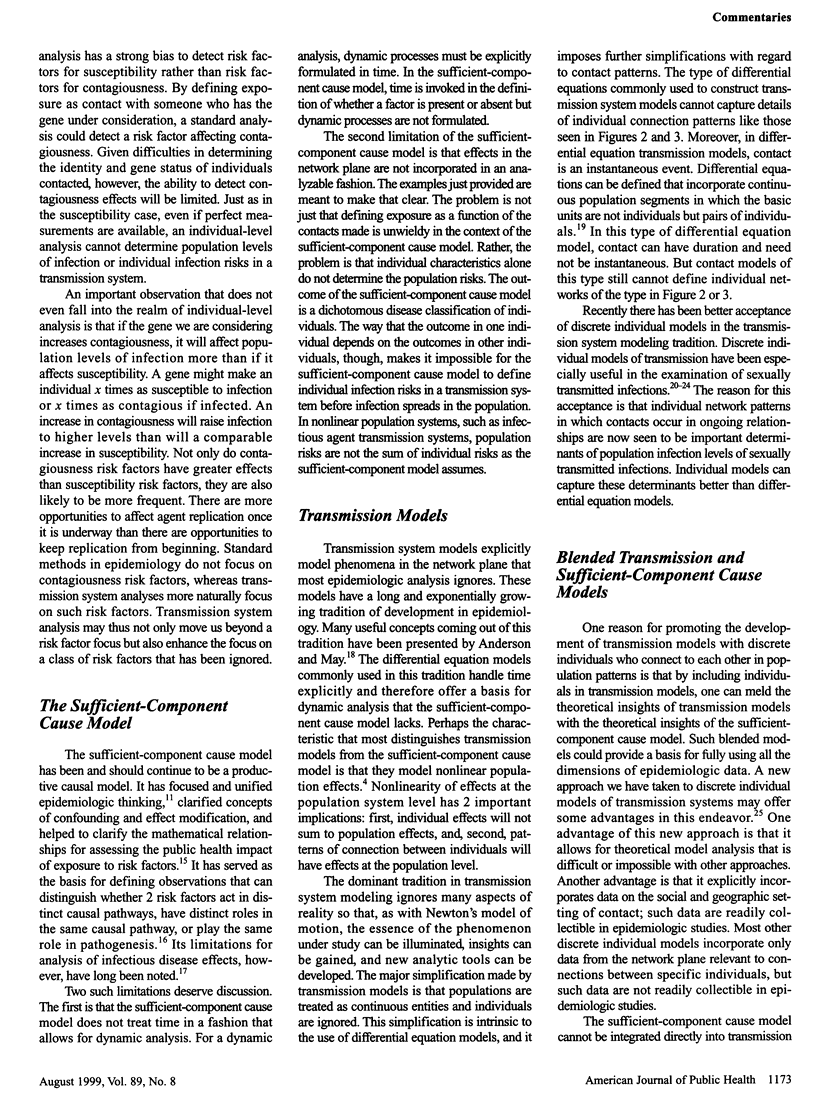
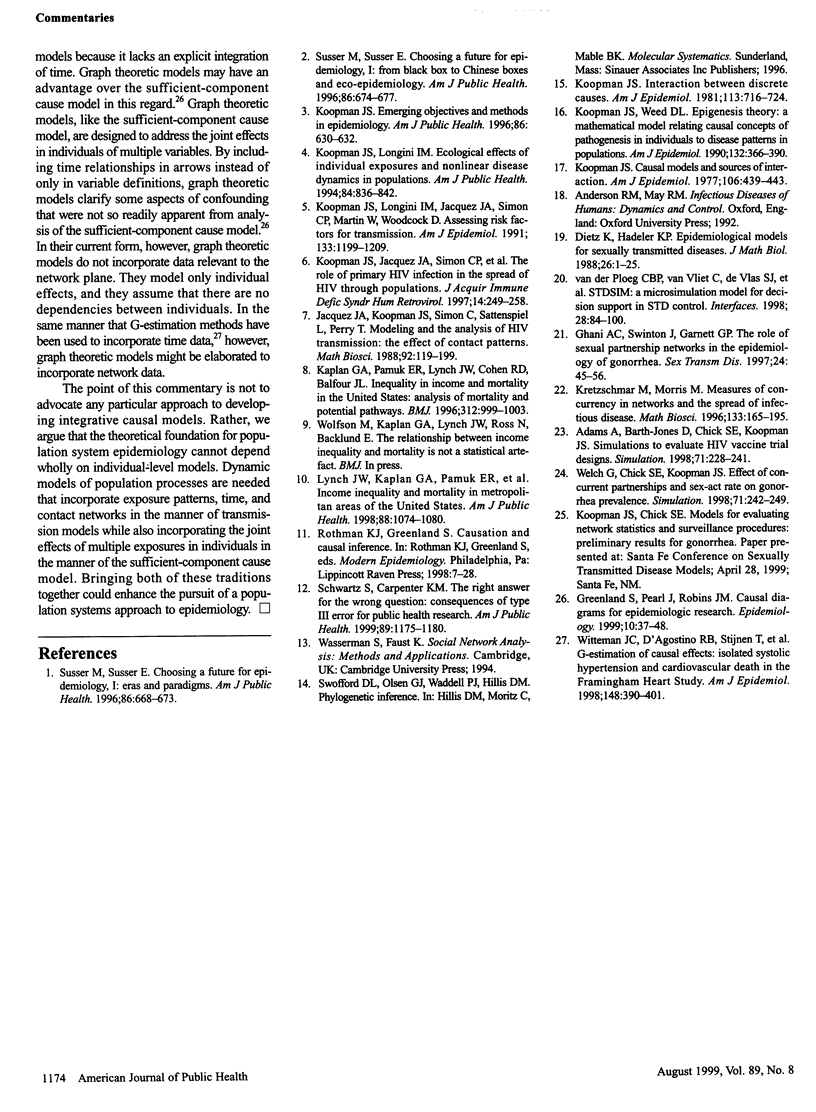
Selected References
These references are in PubMed. This may not be the complete list of references from this article.
- Dietz K., Hadeler K. P. Epidemiological models for sexually transmitted diseases. J Math Biol. 1988;26(1):1–25. doi: 10.1007/BF00280169. [DOI] [PubMed] [Google Scholar]
- Ghani A. C., Swinton J., Garnett G. P. The role of sexual partnership networks in the epidemiology of gonorrhea. Sex Transm Dis. 1997 Jan;24(1):45–56. doi: 10.1097/00007435-199701000-00009. [DOI] [PubMed] [Google Scholar]
- Greenland S., Pearl J., Robins J. M. Causal diagrams for epidemiologic research. Epidemiology. 1999 Jan;10(1):37–48. [PubMed] [Google Scholar]
- Kaplan G. A., Pamuk E. R., Lynch J. W., Cohen R. D., Balfour J. L. Inequality in income and mortality in the United States: analysis of mortality and potential pathways. BMJ. 1996 Apr 20;312(7037):999–1003. doi: 10.1136/bmj.312.7037.999. [DOI] [PMC free article] [PubMed] [Google Scholar]
- Koopman J. S. Causal models and sources of interaction. Am J Epidemiol. 1977 Dec;106(6):439–444. doi: 10.1093/oxfordjournals.aje.a112489. [DOI] [PubMed] [Google Scholar]
- Koopman J. S. Emerging objectives and methods in epidemiology. Am J Public Health. 1996 May;86(5):630–632. doi: 10.2105/ajph.86.5.630. [DOI] [PMC free article] [PubMed] [Google Scholar]
- Koopman J. S., Jacquez J. A., Welch G. W., Simon C. P., Foxman B., Pollock S. M., Barth-Jones D., Adams A. L., Lange K. The role of early HIV infection in the spread of HIV through populations. J Acquir Immune Defic Syndr Hum Retrovirol. 1997 Mar 1;14(3):249–258. doi: 10.1097/00042560-199703010-00009. [DOI] [PubMed] [Google Scholar]
- Koopman J. S., Longini I. M., Jr, Jacquez J. A., Simon C. P., Ostrow D. G., Martin W. R., Woodcock D. M. Assessing risk factors for transmission of infection. Am J Epidemiol. 1991 Jun 15;133(12):1199–1209. doi: 10.1093/oxfordjournals.aje.a115832. [DOI] [PubMed] [Google Scholar]
- Koopman J. S., Longini I. M., Jr The ecological effects of individual exposures and nonlinear disease dynamics in populations. Am J Public Health. 1994 May;84(5):836–842. doi: 10.2105/ajph.84.5.836. [DOI] [PMC free article] [PubMed] [Google Scholar]
- Koopman J. S., Weed D. L. Epigenesis theory: a mathematical model relating causal concepts of pathogenesis in individuals to disease patterns in populations. Am J Epidemiol. 1990 Aug;132(2):366–390. doi: 10.1093/oxfordjournals.aje.a115666. [DOI] [PubMed] [Google Scholar]
- Kretzschmar M., Morris M. Measures of concurrency in networks and the spread of infectious disease. Math Biosci. 1996 Apr 15;133(2):165–195. doi: 10.1016/0025-5564(95)00093-3. [DOI] [PubMed] [Google Scholar]
- Lynch J. W., Kaplan G. A., Pamuk E. R., Cohen R. D., Heck K. E., Balfour J. L., Yen I. H. Income inequality and mortality in metropolitan areas of the United States. Am J Public Health. 1998 Jul;88(7):1074–1080. doi: 10.2105/ajph.88.7.1074. [DOI] [PMC free article] [PubMed] [Google Scholar]
- Schwartz S., Carpenter K. M. The right answer for the wrong question: consequences of type III error for public health research. Am J Public Health. 1999 Aug;89(8):1175–1180. doi: 10.2105/ajph.89.8.1175. [DOI] [PMC free article] [PubMed] [Google Scholar]
- Susser M., Susser E. Choosing a future for epidemiology: I. Eras and paradigms. Am J Public Health. 1996 May;86(5):668–673. doi: 10.2105/ajph.86.5.668. [DOI] [PMC free article] [PubMed] [Google Scholar]
- Susser M., Susser E. Choosing a future for epidemiology: II. From black box to Chinese boxes and eco-epidemiology. Am J Public Health. 1996 May;86(5):674–677. doi: 10.2105/ajph.86.5.674. [DOI] [PMC free article] [PubMed] [Google Scholar]
- Witteman J. C., D'Agostino R. B., Stijnen T., Kannel W. B., Cobb J. C., de Ridder M. A., Hofman A., Robins J. M. G-estimation of causal effects: isolated systolic hypertension and cardiovascular death in the Framingham Heart Study. Am J Epidemiol. 1998 Aug 15;148(4):390–401. doi: 10.1093/oxfordjournals.aje.a009658. [DOI] [PubMed] [Google Scholar]


